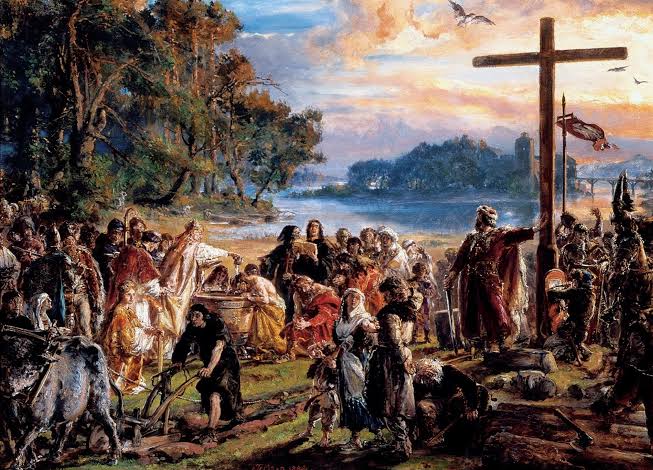Jan Matejko (1838-1893) stands as one of Poland’s most revered painters, celebrated for his monumental contributions to historical painting. His works are characterized by their meticulous detail, dramatic compositions, and rich symbolism, offering deep insights into Poland’s past. Matejko’s paintings not only depict historical events but also reflect his patriotism and dedication to Polish culture and history, making him a central figure in the country’s artistic heritage.
Early Life and Influences
Born in Kraków, Matejko showed an early aptitude for art. His father, a Czech music teacher, and his Polish mother, who died when Matejko was very young, both played influential roles in his development. Despite facing financial hardships, Matejko was admitted to the School of Fine Arts in Kraków at the age of 14, where his talents quickly became apparent. He further honed his skills in Munich and Vienna, where he was influenced by the grand historical and romantic styles prevalent at the time.
Major Works and Themes
Matejko’s oeuvre is dominated by large-scale historical paintings, each infused with detailed character studies and vivid, dynamic scenes. His works are not merely artistic representations but are also imbued with a deep sense of national identity and historical significance. Paintings such as “Rejtan – The Fall of Poland,” “The Battle of Grunwald,” and “The Prussian Homage” are some of his most famous, each depicting critical moments in Polish history with a powerful emotional and narrative impact.
“Rejtan – The Fall of Poland”
One of Matejko’s most poignant works, “Rejtan – The Fall of Poland,” captures the dramatic moment in 1773 when Tadeusz Rejtan, a Polish nobleman, protested against the Partition of Poland by throwing himself in front of the door to prevent the signing of the partition treaty. The painting is a masterful display of tension and emotion, with Rejtan’s desperate gesture symbolizing the futile struggle to preserve Poland’s sovereignty. Matejko’s attention to detail and his ability to convey the profound despair and conflict of the moment make this painting a timeless testament to Polish patriotism.
“The Battle of Grunwald”
“The Battle of Grunwald,” another masterpiece, depicts the 1410 battle between the Kingdom of Poland and the Teutonic Knights. The painting is a chaotic and intense portrayal of medieval warfare, filled with dynamic figures and dramatic interactions. Matejko’s ability to capture the sheer scale and ferocity of the battle, while also paying meticulous attention to historical accuracy in the armor, weaponry, and banners, showcases his exceptional skill as a historian and artist. This work remains a powerful symbol of Polish resilience and victory.
“The Prussian Homage”
In “The Prussian Homage,” Matejko illustrates the 1525 event in which Albert, Duke of Prussia, paid homage to the Polish king, Sigismund I the Old. This painting stands out for its grand composition and the intricate details of the royal court. Matejko’s portrayal of the various figures, each with distinct expressions and postures, brings to life the complex political and social dynamics of the time. The painting not only commemorates a significant historical event but also reflects Matejko’s dedication to depicting Poland’s rich cultural heritage.
“Stanczyk”
Among Matejko’s diverse body of work, “Stanczyk” holds a unique place. Painted in 1862, this portrait of the famous Polish court jester is one of Matejko’s most introspective and evocative pieces. Unlike his grand historical canvases, “Stanczyk” focuses on a single figure, capturing a moment of profound reflection and melancholy.
“Stanczyk” painting, dressed in his jester’s garb, sits alone in a dimly lit room, his face marked by deep contemplation and sorrow. The background hints at a festive scene, contrasting sharply with the jester’s somber mood. Through this painting, Matejko conveys the duality of Stanczyk’s role – outwardly a figure of humor and wit, but inwardly a keen observer of the political and social turmoil of his time. This work is a poignant reminder of the often-overlooked wisdom and insight of those who lived on the margins of power.
Later Works and Legacy
Matejko’s later works continued to explore significant historical themes and events, solidifying his reputation as the chronicler of Polish history. “The Constitution of May 3, 1791” and “The Union of Lublin” are notable examples of his mature style, marked by even greater attention to historical detail and compositional complexity. In these works, Matejko not only depicted historical events but also imbued them with contemporary relevance, highlighting the ongoing struggles for freedom and national identity in Poland.
Beyond his paintings, Matejko’s influence extended to his role as a teacher and mentor. As the director of the Kraków School of Fine Arts, he nurtured a new generation of Polish artists, encouraging them to explore national themes and contribute to the cultural revival of the nation. His dedication to both his art and his country left an indelible mark on Polish culture, inspiring countless artists and patriots.
Conclusion
Jan Matejko’s legacy is one of profound artistic achievement and patriotic fervor. His paintings are not just historical records but are imbued with a deep emotional and symbolic resonance that continues to inspire and move viewers. Through his meticulous attention to detail, dramatic compositions, and passionate dedication to Polish history, Matejko created a body of work that stands as a testament to the enduring spirit of Poland. His influence remains strong, and his works continue to be celebrated and studied as masterpieces of historical painting.










